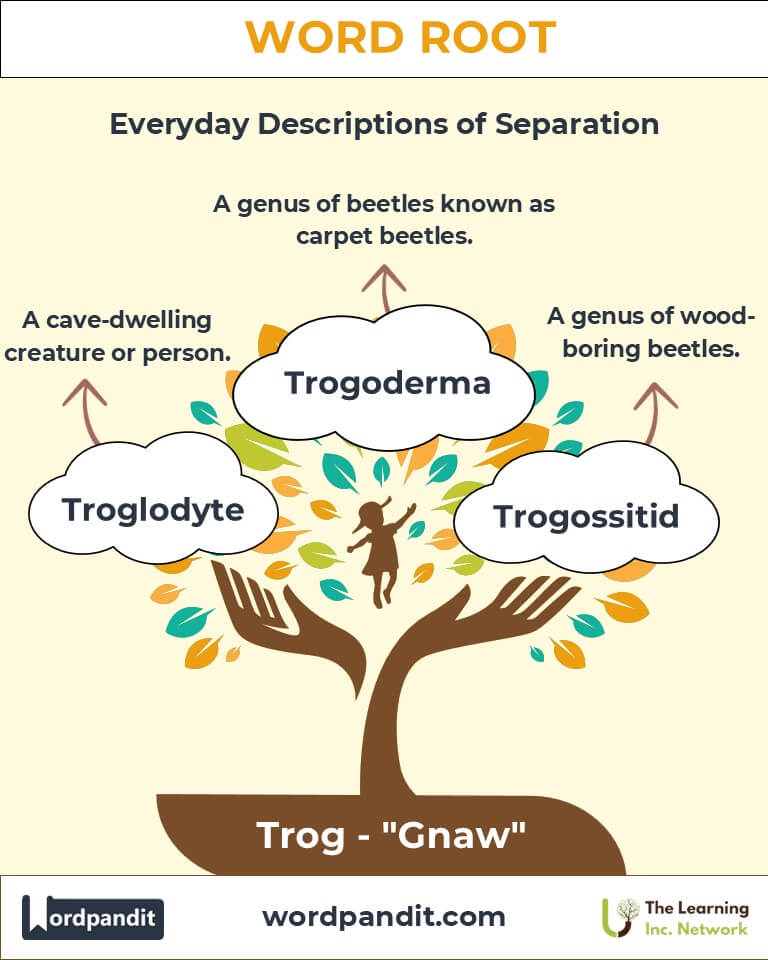Trog: The Root of Gnawing and Persistence
Discover the compelling origin and diverse applications of the root "trog," meaning "gnaw." From the ancient imagery of burrowing creatures to its use in modern scientific terminology, "trog" illustrates persistence and survival across disciplines.

Table of Contents
- Introduction: The Essence of "Trog"
- Etymology and Historical Journey
- Mnemonic: Unlocking the Power of "Trog"
- Common "Trog"-Related Terms
- "Trog" Through Time
- "Trog" in Specialized Fields
- Illustrative Story: "Trog" in Action
- Cultural Significance of "Trog"
- The "Trog" Family Tree
- FAQs about the "Trog" Word Root
- Test Your Knowledge: "Trog" Mastery Quiz
- Conclusion: The Living Legacy of "Trog"
Introduction: The Essence of "Trog"
The root "trog," pronounced trog, carries the primal meaning of "gnaw." Derived from ancient roots symbolizing erosion or persistent chewing, "trog" has left its mark in language, culture, and science. From troglodytes (cave-dwelling creatures) to the obscure trogossitid (a beetle genus), this root demonstrates how persistence and gnawing are universal motifs of life and survival.

Etymology and Historical Journey
The word root "trog" traces back to Greek origins, specifically the verb trogein (to gnaw). In ancient times, it was often associated with animals or processes involving slow, persistent erosion or eating. As language evolved, "trog" extended metaphorically, describing not just physical actions but traits like tenacity and endurance.
Mnemonic: Unlocking the Power of "Trog"
To remember "trog," imagine a rodent persistently gnawing through wood to reach its goal. This vivid imagery ties the root to its core meaning of persistence and erosion.
Mnemonic Device: "Trog is the gnawing force—persistent, steady, unstoppable."
Common "Trog"-Related Terms
- Troglodyte (TROG-luh-dyte): A cave dweller, historically used to describe early humans or animals that inhabit caves.
Example: "The explorers discovered evidence of ancient troglodytes in the caves of southern France." - Trogossitid (TROG-oh-sit-id): A genus of beetles known for their wood-boring habits.
Example: "Trogossitid beetles play a significant role in forest ecosystems by decomposing dead trees."
"Trog" Through Time
- Troglodytes in Ancient Lore: Early Greek texts described troglodytes as mythical cave dwellers, often depicted as primitive yet resourceful beings.
- Trogossitid Beetles in Modern Ecology: First documented in the 19th century, these beetles highlight the enduring biological importance of species adapted to gnawing and decomposition.
"Trog" in Specialized Fields
- Paleontology:
- Troglodyte refers to early hominids or animals dwelling in caves.
- Significance: Insights into human and animal adaptation during prehistoric eras.
- Entomology:
- Trogossitid beetles contribute to wood decomposition, aiding in nutrient cycling.
- Relevance: Essential for forest health and biodiversity.
- Literature:
- The term "troglodyte" has been used metaphorically to describe reclusive or primitive behavior in modern works.
- Example: "The character was a troglodyte, avoiding society and living in isolation."
Illustrative Story: "Trog" in Action
Deep in the forests of Amazonia, a scientist named Dr. Rivera studied the role of trogossitid beetles in maintaining the ecosystem. She observed these persistent insects gnawing through layers of dead wood, creating tunnels that provided shelter for smaller organisms. Inspired by their tenacity, Dr. Rivera published her findings, showcasing how the humble "gnawers" were vital to the circle of life.
Cultural Significance of "Trog"
The root "trog" resonates with themes of endurance and primal instincts. Whether in mythology, where cave-dwelling troglodytes symbolized survival, or in science, where trogossitid beetles represent ecological resilience, the root emphasizes nature’s relentless persistence.

The "Trog" Family Tree
- Rod (Latin: "gnaw")
- Rodent: A gnawing mammal.
- Erode: Gradual wearing away.
- Dent (Latin: "tooth")
- Indent: A notch or recess.
- Dental: Pertaining to teeth.
- Corrode (Latin: "to gnaw through")
- Corrosion: The process of being gradually destroyed.
FAQs About " Trog "
Q: What does the root "Trog" mean?
A: "Trog" originates from the Greek word trogein, meaning "to gnaw" or "to nibble." It often describes eating behaviors or actions associated with slow, repetitive biting.
Q: How is "Trog" used in biology?
A: In biology, "Trog" is used to describe feeding behaviors in animals. For instance, troglodytes, a term for certain cave-dwelling animals or organisms, reflects their gnawing or nibbling survival techniques.
Q: What is a troglodyte?
A: A troglodyte originally referred to a cave-dweller, derived from the root "Trog" for gnawing or nibbling. It’s also used metaphorically to describe reclusive or primitive individuals.
Q: How does "Trog" apply to paleontology?
A: In paleontology, "Trog" may describe the dietary habits of ancient species based on their tooth marks or wear patterns. For example, fossils with gnaw marks suggest troglodytic behavior in certain prehistoric creatures.
Q: Is "Trog" relevant in linguistics?
A: Yes, "Trog" appears in terms like "troglodytic," metaphorically describing outdated or simplistic thought patterns, akin to a gnawing, repetitive mindset.
Test Your Knowledge: " Trog " Mastery Quiz
1. What does "Trog" mean?
2. What is a troglodyte?
3. How is "Trog" connected to paleontology?
4. What does "troglodytic" metaphorically describe?
5. In biology, what does "Trog" describe?
Conclusion: The Living Legacy of "Trog"
The root "trog" symbolizes persistence and adaptation, qualities reflected in both natural and metaphorical contexts. From ancient cave dwellers to industrious beetles, "trog" reminds us of the enduring power of persistence in shaping the world around us. Explore its rich legacy and embrace its lessons of resilience in your endeavors!












